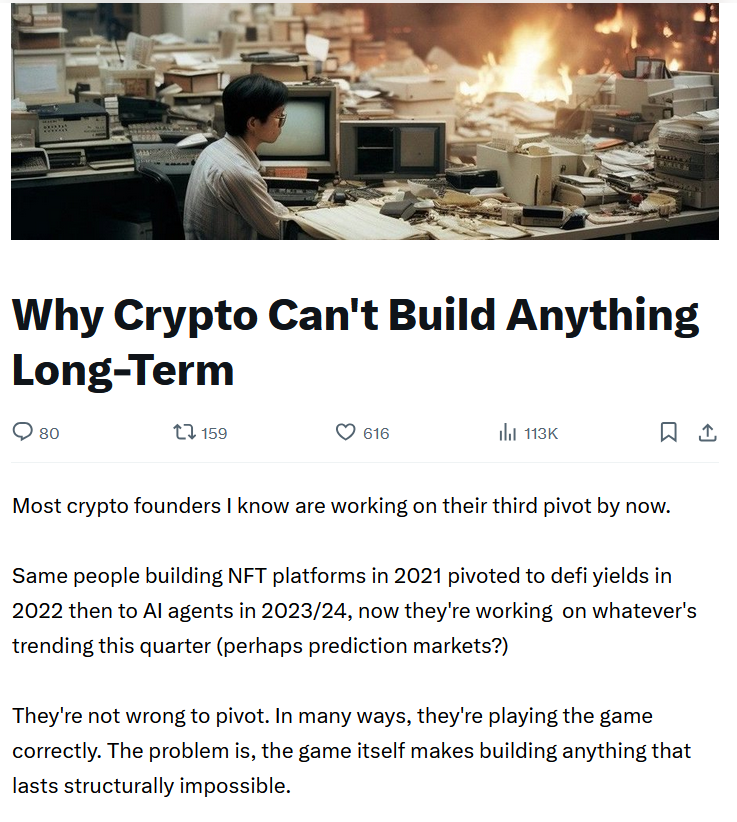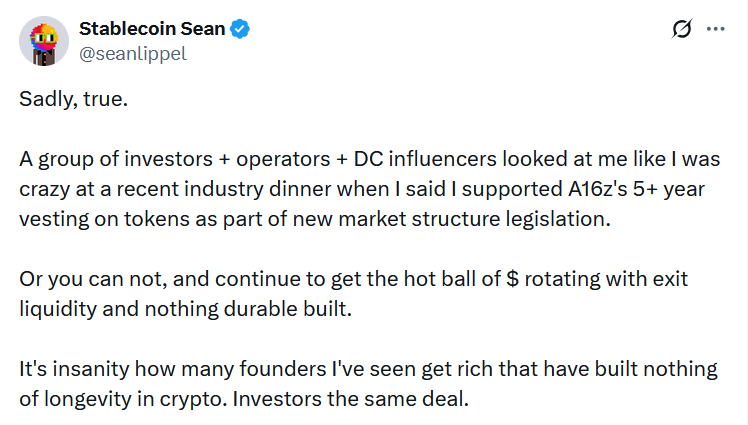Crypto projects struggle to build long-term due to shrinking product cycles and constant pivoting driven by investor pressures and fleeting narratives. According to Ten Protocol’s Rosie Sargsian, the typical 18-month cycle forces founders to chase hype, preventing meaningful infrastructure development that requires 3-5 years.
-
Crypto’s 18-month product cycle shortens from earlier 3-4 year ICO eras, with venture funding dropping nearly 60% in Q2 2025.
-
Founders pivot at signs of resistance, like slow user growth or fundraising challenges, abandoning long-term iteration.
-
Token launches and airdrops attract early adopters but often lead to dumps, exacerbating retention issues post-hype.
Crypto long-term building faces constant pivots and 18-month cycles, as Ten Protocol’s Rosie Sargsian warns. Discover why projects can’t sustain and how to overcome investor-driven hurdles. Read now for expert insights.
Why Can’t Crypto Build Anything Long-Term?
Crypto long-term building is hindered by rapid narrative shifts and investor demands that force projects into frequent pivots, preventing the deep iteration needed for sustainable success. Ten Protocol’s head of growth, Rosie Sargsian, highlights how founders often abandon promising ideas at the first sign of trouble, mistaking traditional business pivots for crypto’s high-stakes environment. This results in a landscape where no project stays committed long enough to achieve true product-market fit, which typically demands years of refinement rather than mere quarters.
Shrinking product cycles and constant pivoting mean nobody in crypto stays with anything long enough to know if it works, argues Ten Protocol’s Rosie Sargsian.
Most crypto projects will struggle to build anything long-term as they are forced to constantly chase new narratives to attract investors, according to Ten Protocol’s head of growth, Rosie Sargsian.
In a Saturday article posted on X titled “Why Crypto Can’t Build Anything Long-Term,” Sargsian suggested many crypto founders have paper hands, switching gears at the first sight of trouble.
“Traditional business advice: don’t fall for sunk cost fallacy. If something isn’t working, pivot. Crypto took that and did sunk-cost-maxxing,” she wrote, adding:
“Now nobody stays with anything long enough to know if it works. First sign of resistance: pivot. Slow user growth: pivot. Fundraising getting hard: pivot.”

Source: Rosie Sargsian
What Is Crypto’s 18-Month Product Cycle?
The 18-month product cycle in crypto represents a compressed timeline where new narratives emerge, drawing in funding and attention before interest wanes, compelling projects to pivot yet again. Sargsian explains that this cycle builds over six to nine months amid hype, only to fade, leaving founders scrambling for the next trend. Data from industry reports shows crypto venture funding plummeted nearly 60% in Q2 2025 alone, intensifying the pressure on time and resources.
Sargsian argued that there is now an 18-month product cycle in crypto, in which a new narrative emerges, funding and capital start flowing in, and everybody pivots amid the hype.
It builds up over six to nine months, then ultimately interest dies down, and founders then look for the next pivot.
“This cycle used to be 3-4 years (during ICO era). Then 2 years. Now it’s 18 months if you’re lucky. Crypto venture funding dropped nearly 60% in just one quarter (Q2 2025), squeezing the time and money founders have to build before the next trend forces another pivot,” she said.
Sargsian didn’t necessarily blame the crypto project founders, as she acknowledged they are playing “the game correctly,” but the “game itself” almost makes it impossible for projects to see their ideas through to the long term.
“The problem is, you can’t build anything meaningful in 18 months. Real infrastructure takes at least 3-5 years. Real product-market fit requires iteration over years, not quarters,” she said, adding:
“But if you are still working on last year’s narrative, you’re dead money. Investors ghost you. Users leave. Some investors even force you to catch the current narrative. And your team starts interviewing at whatever project just raised on this quarter’s hot narrative.”
This cycle echoes patterns seen in past booms, such as the ICO surge of 2017-2018, where initial enthusiasm gave way to regulatory scrutiny and market corrections. Today, sectors like decentralized finance (DeFi) and non-fungible tokens (NFTs) follow similar trajectories, with rapid adoption followed by sharp declines in activity. According to blockchain analytics firm Chainalysis, total crypto venture capital investments fell from peaks in 2021 to stabilized but lower levels by 2025, underscoring the funding volatility Sargsian describes. Experts like those at a16z have long advocated for longer vesting periods on tokens to encourage sustained commitment, yet adoption remains uneven.
Hurdles to Thinking Long-Term in Crypto
One major barrier to crypto long-term building is the reliance on short-term incentives like token launches and airdrops, which draw users but fail to foster lasting engagement once hype subsides. Sectors such as NFTs exemplify this boom-and-bust pattern, where explosive growth in trading volumes—peaking at over $23 billion in early 2022 per DappRadar data—quickly contracts, leaving platforms struggling for relevance. Without robust mechanisms for retention, early participants often sell off rewards, eroding value and discouraging ongoing development.
Tools like token launches and airdropped rewards for early adopters have been essential tools for drawing interest; however, without sufficient structuring and planning, they can result in early investors dumping right after the token drops and abandoning the platform.
Responding to Sargsian’s post, Sean Lippel, general partner at venture capital firm FinTech Collective, echoed similar sentiments, but went to claim that some founders or investors don’t want solutions that promote broader long-term thinking.

Source: Sean Lippel
“A group of investors + operators + DC influencers looked at me like I was crazy at a recent industry dinner when I said I supported A16z’s 5+ year vesting on tokens as part of new market structure legislation,” he said, adding that it’s “insanity how many founders I’ve seen get rich that have built nothing of longevity in crypto.”
Lippel’s observation points to a cultural resistance within the ecosystem, where quick flips and narrative-chasing yield immediate gains over patient innovation. Regulatory discussions, including proposals from the U.S. Securities and Exchange Commission on token classifications, further complicate long-term planning by introducing uncertainty. Yet, projects that buck this trend, such as layer-1 blockchains like Ethereum, demonstrate success through iterative upgrades over years, amassing a developer community exceeding 200,000 active contributors as reported by Electric Capital’s developer reports.
Incentivizing longevity requires rethinking reward structures, perhaps through governance models that lock contributions or community-driven roadmaps. Sargsian’s critique aligns with broader industry analyses from firms like Messari, which note that only 20% of crypto startups from 2021 cohorts remain active in their original focus by 2025, highlighting the pivot peril.
Frequently Asked Questions
How Does Constant Pivoting Impact Crypto Project Success?
Constant pivoting in crypto disrupts project success by halting the iteration needed for product-market fit, often leading to abandoned user bases and wasted resources. As Rosie Sargsian notes, this behavior stems from investor pressures, resulting in only 18 months of focus per narrative. Long-term viability demands at least 3-5 years of commitment to build robust infrastructure.
What Role Do Token Airdrops Play in Crypto’s Short-Term Focus?
Token airdrops in crypto effectively bootstrap adoption by rewarding early users, but they contribute to short-term focus when participants dump rewards post-distribution. This pattern, seen in projects like Uniswap, can inflate initial metrics while undermining sustained growth. To counter this, structured vesting and utility-driven designs are essential for encouraging ongoing engagement.
Key Takeaways
- Shortened Cycles Limit Depth: Crypto’s 18-month product cycles, down from 3-4 years in the ICO era, prevent meaningful development as funding drops sharply, like the 60% decline in Q2 2025.
- Pivoting Pressures Founders: Investor demands and hype force shifts at early resistance, leading to “dead money” for outdated narratives and team attrition to trendier projects.
- Need for Retention Strategies: Beyond airdrops, implement long vesting and community governance to build loyalty, avoiding the boom-bust traps in sectors like NFTs.
Conclusion
The challenges of crypto long-term building stem from relentless pivoting, compressed 18-month cycles, and incentive misalignments that prioritize hype over endurance, as articulated by experts like Rosie Sargsian and Sean Lippel. While the ecosystem’s dynamism drives innovation, true progress requires cultural shifts toward sustained commitment and regulatory support for longevity. As crypto matures, projects embracing multi-year horizons will lead, offering investors and users more resilient foundations—stay informed to identify those poised for lasting impact.





